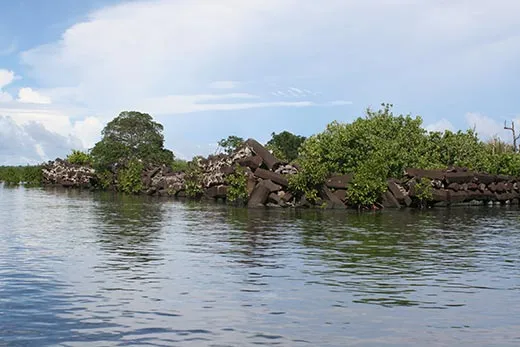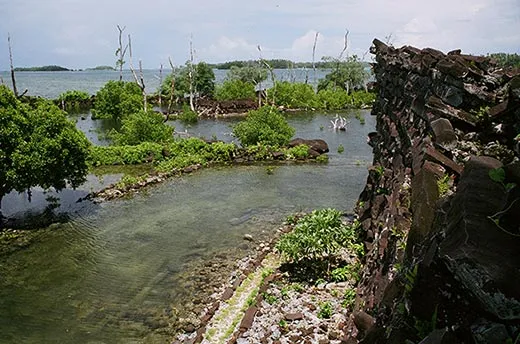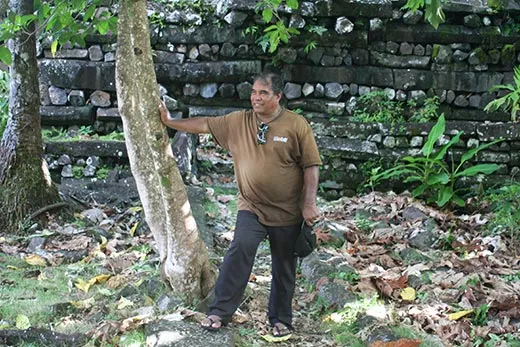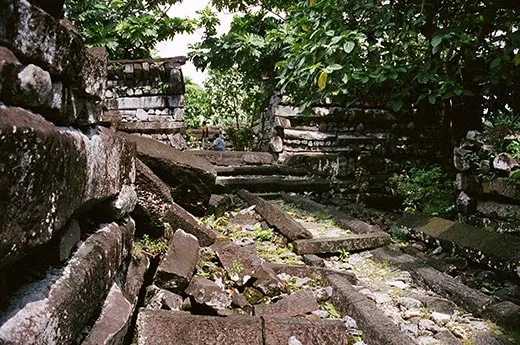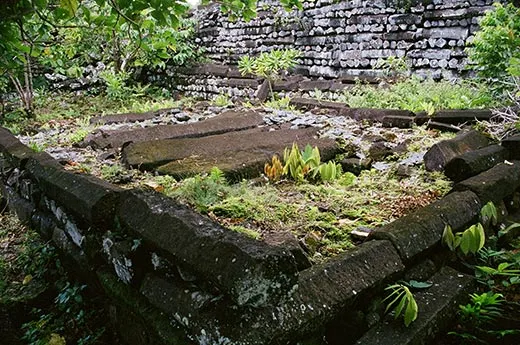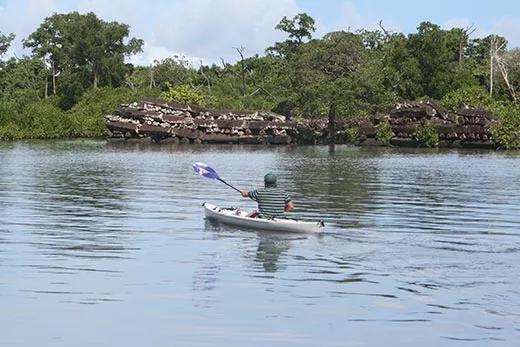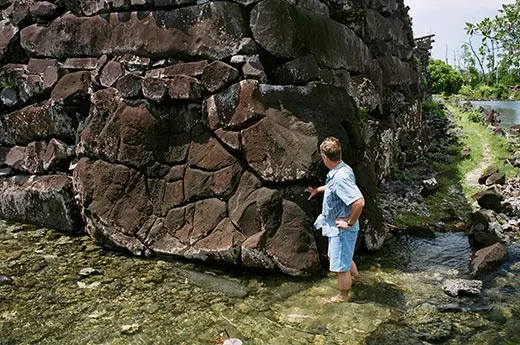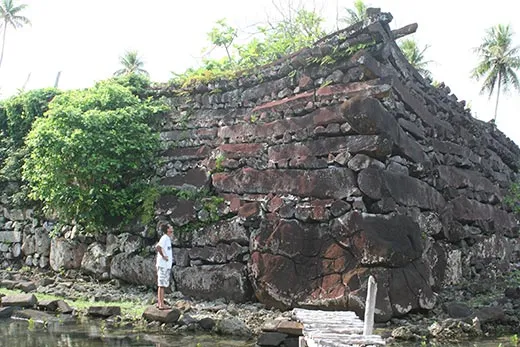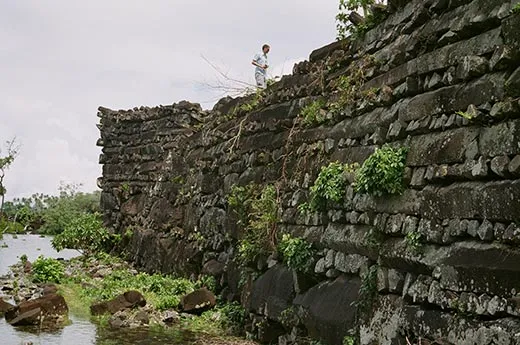Nan Madol: The City Built on Coral Reefs
One of the oldest archaeological sites not on a heritage list, this Pacific state, like Easter Island, is an engineering marvel
/https://tf-cmsv2-smithsonianmag-media.s3.amazonaws.com/filer/Nan-Madol-631.jpg)
We zigzag slowly in our skiff around the shallow coral heads surrounding Pohnpei. The island, a little smaller than New York City, is part of the Federated States of Micronesia. It is nestled in a vast tapestry of coral reefs. Beyond the breakers, the Pacific stretches 5,578 miles to California. A stingray dashes in front of us, flying underwater like a butterfly alongside our bow.
Our destination is Nan Madol, near the southern side of the island, the only ancient city ever built atop of a coral reef. Its imposing yet graceful ruins are made of stones and columns so heavy that no one has figured out how it was built. Besides the elegance of the walls and platforms, there is no carving, no art – nothing except legend to remember the people, called the Saudeleur, who ruled the island for more than a millennium. They were deeply religious and sometimes cruel, and modern Pohnpeians view the ruins as a sacred and scary place where spirits own the night.
Abandoned centuries ago and now mostly covered with jungle, Nan Madol may soon be getting a makeover. Before I explore it, I stop to discuss its future with the man who holds sway over this part of Pohnpei.
We nuzzle up to land and jump onto the remnants of a sea wall. I follow Rufino Mauricio, Pohnpei’s only archaeologist, along a path and up a hill to what appears to be a warehouse, painted white with a corrugated metal roof. It’s known here as the Tin Palace. There is a small house tacked on the end, with flowering bushes here and there. A gaggle of dogs welcome us noisily. This is the residence of the Nahnmwarki of Madolenihmw, the primus inter pares among the five traditional paramount chiefs who preside over a delightfully complex social structure that underpins Pohnpei's vibrant native culture.
Aside from Easter Island, Nan Madol is the main archaeological site in Oceania that is made up of huge rocks. But while Easter Island gets 50,000 visitors a year, Nan Madol sees fewer than 1,000. Before I left on this trip, Jeff Morgan, director of the Global Heritage Fund of Palo Alto, California, had told me he wanted to fund a rehabilitation program. But before anything can be done, ownership issues that blocked previous rehabilitation efforts would have to be resolved—the state government and the Nahnmwarki both claim sovereignty over the ruins. A resolution would pave the way for Nan Madol to become a Unesco World Heritage site, increasing the flow of visitors and grants.
“Nan Madol is one of the most significant sites not yet on the World Heritage List,” says Richard Engelhart, an archaeologist and former Unesco adviser for Asia and the Pacific.
Mauricio and I are a bit nervous: an audience with the Nahnmwarki is best arranged through Pohnpei’s governor, John Ehsa. A day earlier, Ehsa had pledged to support the Global Heritage Fund’s idea and promised to arrange an audience with the Nahnmwarki so that I could interview him about the plan—but then Ehsa didn’t come through on his promise. Ehsa had noted that a previous attempt to clean up the ruins had foundered because the Japanese donors had not followed proper protocol with the Nahnmwarki.
Sadly, neither do I. It’s unthinkable to arrive without a tribute, but the bottle of Tasmanian wine I brought for the occasion slipped out of my hand and shattered on the rocks as I got off the boat. Mauricio, who holds a lesser traditional title, is mortified: he didn’t know we were stopping to see the chief on our way to the ruins, so he is empty-handed too.
Arriving empty-handed without an appointment is the height of rudeness, he grumbles.
Mauricio, who, as I am, is dripping with sweat in Ponhpei’s steamy equatorial heat, informs the chief’s wife of our arrival.
The Nahnmwarki agrees to see us and we walk back to the other end of the building so we can make our entry from the visitors’ side. Mauricio, who earned a PhD from the University of Oregon with a thesis on Nan Madol, kneels. He addresses the chief, a former teacher and school bus driver, who finishes buttoning up a russet aloha shirt and tan shorts and sits at the head of a small staircase. He has short, thick hair and, like most people in Pohnpei, his teeth are stained by betel nut, which he chews during out meeting, occasionally walking over to the door to spit.
Through Mauricio, who translates, I inquire: Would the Nahnmwarki be interested in setting aside old grievances and cooperating with the state and other stakeholders in order to take advantage of this opportunity?
“I would love to see Nan Madol rehabilitated, but it has to be under my supervision,” he replies, later adding, “All funding should go through the Madolenihmw municipal government, not the Pohnpei state government.” The municipal government is the heir to the Nahnmwarki’s rule.
On the way back, Mauricio, who is director of the national archives, says thoughtfully, “It’s a reasonable request. Certainly, the national government [of the Federated States of Micronesia] would have no objection.”
Back on the skiff, Augustine Kohler, the state historical preservation officer and himself the son of another of Pohnpei’s five Nahnmwarkis, says, “It could work.”
We head for the ruins in the boat to take a look at what kind of rehabilitation would be appropriate. On the way, Mauricio explains that Nan Madol is composed of 92 artificial islands spread over 200 acres abutting Pohnpei’s mangrove-covered shore. Most of it was built from the 13th to the 17th centuries by the Saudeleurs, descendants of two brothers of unknown provenance who founded a religious community in the sixth century focused on the adoration of the sea. On their third attempt to build their political, religious and residential center, they settled on this patch of coral flats. They and their successors brought from the other side of the island columns of black lava rock up to 20 feet long that are naturally pentagonal or hexagonal and straight. They used them in a log cabin formation to build outer walls as well as foundations filled in with lumps of coral to create elevated platforms where traditional thatched structures were used as lodgings. Even with all the sunshine in the world washing over the thick green jungle and aquamarine water beyond, the unadorned black architecture is intimidating.
The tyrannical last Saudeleur ruler was overthrown by an outsider named Isohkelekel who instituted the system of multiple chiefs that remains today. The Nahnmwarki of Madolenihmw is directly descended from him. Because of this bloodline, most Pohnpeians feel he is the legitimate supervisor of the ruins.
As we approach the first building, Mauricio observes, “We don’t know how they brought the columns here and we don’t know how they lifted them up to build the walls. Most Pohnpeians are content to believe they used magic to fly them.”
The easiest way to see Nan Madol is to take a cab from Kolonia, the little capital of Pohnpei, park on an unmarked spot and walk for nearly a mile through a primitive jungle path. When you arrive, only a channel separates you from the main building, the Nandawas. Representatives of the Nahnmwarki with a boat are on hand to collect $3 and take you across. The odds are good that you will have the place to yourself.
Having your own boat at high tide allows you to go much farther. We glide though the channel, the outboard purring. The islands are covered with almost impenetrable jungle. A large component of the rehabilitation effort, if it happens, will be to clear brush to make the buildings accessible. The other component would be dredging the main channels so the ruins are accessible to boats at all times.
Many of the outer walls, usually just a few feet high, are intact. Mauricio points out the little island of Idehd, where priests fed turtle innards to an eel, the sea deity, kept in a well, before sharing among themselves the rest of the turtle as a sacrament. To this day eels are considered holy and never eaten. Then we pass Peikapw, where Isohkelekel resided after he overthrew the last Saudeleur. He eventually committed suicide there after discovering how old he looked when he saw his reflection in a pool, according to the oral history. After he died, Nan Madol was largely abandoned, though religious ceremonies were occasionally held there until the late 19th century.
As we continue, the channel gets narrower and shallower. We turn back to explore the city’s outer walls, still strong, and continue to the islet of Pahnwi, whose wall of huge, flat-sided stone rises 58 feet and encloses a tomb.
Our final stop is Nandowas, by far the most elaborate building. It’s the royal mortuary, with two sets of 25-foot-high walls whose gracefully up-swept corners cover an area greater than a football field. One cornerstone is estimated to weigh 50 tons. I step down into the moss-encrusted tomb. Eight columns form the basis of a roof that lets in shards of sunlight. I’m glad I’m not alone. The bodies of kings were placed here and later buried elsewhere.
On the way back, Mauricio remarks that, given Pohnpei’s population at the time was less than 30,000, the building of Nan Madol represented a much larger effort than the pyramids were for the Egyptians. The total weight of the black rocks moved is estimated at 750,000 metric tons, an average of 1,850 tons a year over four centuries. “Not bad for people who had no pulleys, no levers and no metal,” said Mauricio. Waving at the brush, he adds, “We need to clear all this out in at least some of the islands so we can appreciate the extraordinary effort that was put into this construction.”
